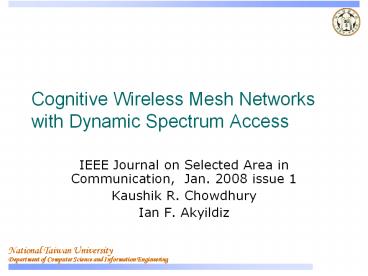Cognitive Wireless Mesh Networks with Dynamic Spectrum Access - PowerPoint PPT Presentation
1 / 31
Title:
Cognitive Wireless Mesh Networks with Dynamic Spectrum Access
Description:
Cognitive Wireless Mesh Networks with Dynamic Spectrum Access ... Decentralized approach gauss elimination. National Taiwan University ... – PowerPoint PPT presentation
Number of Views:574
Avg rating:3.0/5.0
Title: Cognitive Wireless Mesh Networks with Dynamic Spectrum Access
1
Cognitive Wireless Mesh Networks with Dynamic
Spectrum Access
- IEEE Journal on Selected Area in Communication,
Jan. 2008 issue 1 - Kaushik R. Chowdhury
- Ian F. Akyildiz
2
Outline
- Introduction
- Related Work
- COMNET
- Architecture
- Spectrum sensing
- Channel switching
- Performance Evaluation
- Conclusion
3
Introduction
- Wireless Mesh Network (WMN)
- Mesh routers (MR)
- Mesh clients (MC)
4
Introduction
- Performance of WMN limited by
- Channel congestion
- WLAN, Bluetooth device, microwave ovens
- Traffic congestion
- Throughput capacity per node reduces
significantly when node density increase - The Capacity of Wireless Networks, IEEE Trans.
On Information Theory, 2000
5
Introduction
- Urban areas area affected most by channel
congestion - - Capacity of Multi-Channel Wireless Networks
Impact of Number of Channels and Interfaces, ACM
MobiCom 2005
Dynamic Spectrum Access
6
Introduction
- If we have Intelligent and network aware spectrum
selection - Reduce channel congestion
- ? Also reduce node density in per channel reduce
traffic congestion
7
Introduction
- Key challenge
- How to identifying which portions of spectrum are
free to use - Resolving contentions with licensed users
- Load balancing over the entire available spectrum
8
Related work
- Sensing techniques
- Single user detection
- Energy over time and threshold
- Primary user module
- Cooperative detection
- Topology
- TDMA/CDMA like protocol
9
COMNET
- Cognitive wireless Mesh NETwork (COMNET)
- Spectrum sensing and shared algorithm
- Easily integrated into existing mesh scenario
- A theoretical framework for identifying primary
user frequencies through time domain sampling - Formulate channel assignment as an optimization
problem that is solved by MR
10
COMNET Architecture
- Objection
- Intelligent spectrum sensing capability in
standard mesh scenario without advanced
hardware/software techniques
11
COMNET Architecture
- Assumption
- Each MR and MC is equipped with a single IEEE
802.11b based transceiver - It is tunable anytime.
- No computing overhead in MR
- MR-MR multi-hop links are achieved through out of
band communication - No contention between MR-MR traffic with
remaining nodes
12
COMNET Architecture
- Assumption
- MR has a fixed location that is known to all
other MRs - Primary transmitters as stationary
radio/television towers - No restriction on mobility of primary recivers
- MC can calculate its distance from primary
stations
13
COMNET Spectrum Sensing
- Channel sensing based on time domain sampling
- Use of backoff interval for channel sensing
14
COMNET Spectrum Sensing
- Limitations of backoff interval for channel
sensing - Channel switch overhead
15
COMNET Spectrum Sensing
- Estimating channel occupancy by received signal
power alone may not guarantee accurate results
16
COMNET Spectrum Sensing
- Centralized framework for time-domain sensing
- The leakage power of primary transmitters from
other channel - The received power is the sum of the individual
transmit power
Channel for measurement is fixed
Leakage power for each transmitter is isolated
from aggregate received power
17
COMNET Spectrum Sensing
- The individual transmitter channels can be
estimated - Assume simple free space path loss model
I1,x spectral overlap factor between channels
of transmitter and receiver
18
COMNET Spectrum Sensing
Channel for measurement is fixed I1,1 I1,2
I1,3 I1,M
19
COMNET Spectrum Sensing
DX Y ? X D-1Y Assume antenna gains Gt Gr 1
20
COMNET Spectrum Sensing
- Decentralized approach gauss elimination
21
COMNET Channel Switching
- Formulate problem as an ILP.
22
COMNET Channel Switching
23
Performance Evaluation
- Effect of noise power increase
24
Performance Evaluation
- Effect of measurement set numbers
25
Performance Evaluation
- Relationship between min. required sensing nodes
for given primary stations
26
Performance Evaluation
- Centralized and decentralized approach
27
Performance Evaluation
- Chain propagation delay
28
Performance Evaluation
- Channel selection algorithm
- topology
29
Performance Evaluation
- Before channel switching
30
Performance Evaluation
- After channel switching
31
Conclusion
- Combine wireless mesh network and cognitive radio
approach - Spectrum sensing method
- Decentralized approach?

